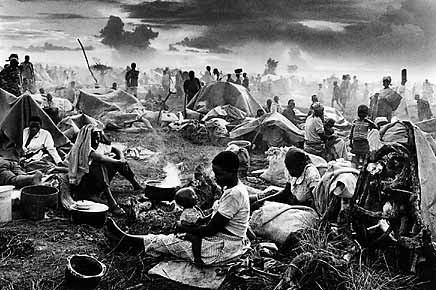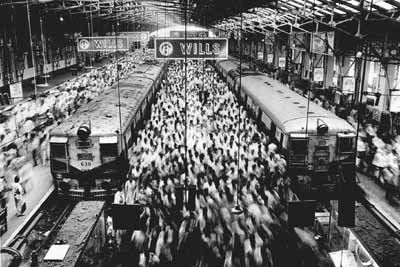|

Refugee
camp at Benako, Tanzania, 1994. © Sebastião
Salgado
Video briefs: Salgado discusses his work | Additional
information


Epic Sebastião Salgado show at the Berkeley Art Museum
8
February 2002
BERKELEY - An
epic exhibition by photographer Sebastião Salgado chronicling
the almost otherworldly existence of displaced people around the world
is the focus of a new show at the Berkeley Art Museum. Concurrent with
this exhibition, Salgado, an acclaimed photographer and human rights
activist, will spend a week in residence on campus starting Monday, Feb.
11.
On February 11 at
Wheeler Auditorium, Salgado delivered an Avenali Lecture that was sponsored
by the Townsend Center for Humanities. The talk was of such interest
that the auditorium was filled and several thousand people were unable
to get into the event. For those who missed it, the entire one hour and
23 minute lecture and subsequent interview of Salgado by Journalism School
Dean Orville Schell can be viewed via webcast.
On February 13, Salgado
participated in a discussion with a panel chaired by Candace Slater,
Director of the Townsend Center for the Humanities. This discussion also
can be viewed via webcast.
The panel included Professors Michael Watts (Geography and Institute
of International Studies), Tim Clark (History of Art), and Nancy Scheper-Hughes
(Anthropology).
| |
|
|
"My
big hope is the person who comes out of the show is not the same as
the one who came in."
--
Sebastião Salgado
|
| |
|
|
|
Through March
24, the Berkeley Art Museum will be exhibiting Salgado's "Migrations"
show, a monumental record of a world on the move. Since it opened
last month, some 1,200 people a week have attended.
"Anyone
has to visit it twice - once to see the pictures and once to
see the faces of the people looking at the pictures," says
Slater, a professor of Brazilian literature. Students especially
are coming to see the work, she notes, and most view the pictures
in silence. "You can see in their faces anger, amazement
and incomprehension."
"Migrations"
chronicles the exodus of refugees, exiles, orphans, homeless
families and boat people, all of whom have been forced from
their homes due to economic pressures, natural disasters and
explosive population growth. Latin Americans entering the United
States, Jews leaving the former Soviet Union, Africans traveling
into Europe and Bosnians seeking shelter in Croatia are among
the travels documented by Salgado, a native of Brazil. The exhibition
features more than 300 black-and-white photographs and is cosponsored
by the Graduate School of Journalism.
With more
than 100 million migrants in the world today – twice the
number there were a decade ago – Salgado’s work speaks
to the scale of mass migration.
"His
work really allows us to think about what's been happening in
the world and then have conversations about our own responsibility,"
says Ken Light, curator of the Center for Photography at the
Graduate School of Journalism, where 15 photos from the "Migrations"
series are on display. "He sees his role as photographer
as a way to spark people's conversation."
At the Berkeley
Art Museum, UC Berkeley graduate students from the Geography
Department, the School of Journalism, and the Art History Department
will offer guided tours of the "Migrations" exhibit
on Thursdays at 12:15 p.m. and Sundays at 2 p.m. unless another
program is scheduled. Contact the Berkeley Art Museum at 510-642-0808
for further information.
Additional
information:

Church Gate Station. Bombay, India, 1995. © Sebastião
Salgado
|